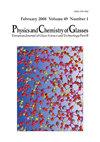Electrical transport studies in Na2O and Fe2O3 containing borate glasses
IF 0.6
4区 材料科学
Q4 CHEMISTRY, PHYSICAL
Physics and Chemistry of Glasses-European Journal of Glass Science and Technology Part B
Pub Date : 2023-04-01
DOI:10.13036/17533562.64.2.20
引用次数: 0
Abstract
A new series of (X) Na2O.(0·5−x)Fe2O3.(0·5)B2O3 of sodium and iron oxides doped borate glasses were synthesised by melt quenching. The bulk density, structural and temperature dependent electrical properties of these glasses have been investigated. The density decreased with increase in Na2O content up to Na2O=0·2 and increased thereafter. The FTIR studies indicated the presence of BO3 and BO4 groups in the network and also has shown presence of minimum NBOs at x=0·2. These results are attributed to the significant structural modifications taking place in the glass network at Na2O=0·20. The dc electrical conductivity decreased with increase in Na2O content up to Na2O=0·20 and increased for further addition of Na2O. The activation energy has increased up to 0·2 mol% of Na2O and decreased thereafter. Based on these results, it is established that at x=0·20, a changeover of dc conduction mechanism predominantly from polaronic to ionic is taking place. Mott’s SPH, Mott’s VRH and Greave’s VRH models have been used to explain the high and low temperature conductivities.含硼酸盐玻璃中Na2O和Fe2O3的电输运研究
采用熔体淬火法制备了一系列新型的(X) Na2O、(0.5−X) Fe2O3、(0.5)B2O3掺杂硼酸盐玻璃。研究了这些玻璃的体积密度、结构和温度相关的电学性能。随着Na2O含量的增加,密度逐渐减小,直至Na2O=0·2,随后逐渐增大。FTIR研究表明,该网络中存在BO3和BO4基团,并且在x= 0.2处存在最小nbo。这些结果是由于在Na2O=0·20时,玻璃网络中发生了显著的结构修饰。当Na2O=0·20时,直流电导率随Na2O含量的增加而降低,随着Na2O的进一步添加而升高。活化能在Na2O浓度为0.2 mol%时升高,随后降低。基于这些结果,确定了在x=0·20时,直流传导机制主要发生了从极化到离子的转变。Mott 's SPH, Mott 's VRH和Greave 's VRH模型已被用于解释高温和低温电导率。
本文章由计算机程序翻译,如有差异,请以英文原文为准。
求助全文
约1分钟内获得全文
求助全文
来源期刊

CiteScore
0.70
自引率
33.30%
发文量
0
审稿时长
1 months
期刊介绍:
Physics and Chemistry of Glasses accepts papers of a more purely scientific interest concerned with glasses and their structure or properties. Thus the subject of a paper will normally determine the journal in which it will be published.
 求助内容:
求助内容: 应助结果提醒方式:
应助结果提醒方式:


